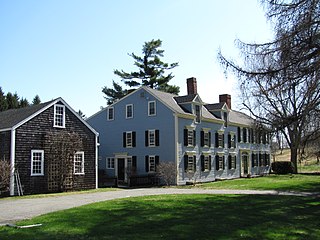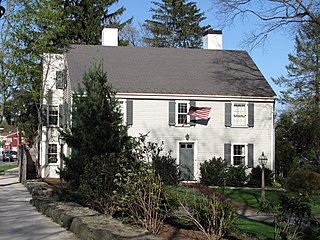
The General Rufus Putnam House is a National Historic Landmark at 344 Main Street in Rutland, Worcester County, Massachusetts, US.

The John Ward House is a National Historic Landmark at 9 Brown Street in Salem, Massachusetts, United States. With an early construction history between 1684 and 1723, it is an excellent example of First Period architecture, and as the subject of an early 20th-century restoration by antiquarian George Francis Dow, it is an important example of the restoration techniques. Now owned by the Peabody Essex Museum, it is also one of the first colonial-era houses in the United States to be opened as a museum. It was designated a National Historic Landmark in 1968.

The Benjamin Cole House is a historic house in Swansea, Massachusetts, United States. Built in 1690, this house is the oldest documented building in Swansea.

The Ambrose Lincoln Jr. House is a historic house located at 1916 Bay Street in Taunton, Massachusetts.

The Amos Morse House was a historic house at 77 North Street in Foxborough, Massachusetts. It was a two-story wood-frame house, five bays wide, with a hip roof and twin interior chimneys. It was a center entry, Federal Colonial design. It was built circa 1803 by Amos Morse, Sr., for his children, Amos Jr. and Sarah. One of its ells was used by the Morses as a shop for producing straw hats, a significant industry in early 19th-century Foxborough.

The Robert Fuller House is a historic house at 3 Burrill Lane in Needham, Massachusetts. Built in 1707 and moved to its present location in 1750, it is the oldest house in Needham. It is a well-preserved example of First Period architecture, adaptively modified over the centuries to adapt to later uses. The house was listed on the National Register of Historic Places in 1987.

The Santuit Historic District encompasses a cluster of historic houses around the junction of Falmouth Road and Main Street in the Santuit village of Barnstable, Massachusetts. It includes eight houses, six of which are historically significant for their association with the Crocker family, who were the first settlers of the area in the 18th century. The district was listed on the National Register of Historic Places in 1987.

The Rea Putnam Fowler House is a historic house in Danvers, Massachusetts. It is a 2+1⁄2-story timber-frame structure, five bays wide with a side gable roof, clapboard siding, and a slender central chimney. A leanto section extends to the rear, giving the house a classic saltbox profile. The leanto section extends beyond one of the sides, creating what is called a "Beverly jog". The front entrance is centered, and is sheltered by a late 18th or early 19th-century porch. The oldest portion of the house, its western three bays and leanto, was built about 1700, and the eastern bays were added about 1725. The original chimney was quite large; the present chimney is a 19th-century replacement, and a second chimney in the leanto is a 20th-century addition. The house underwent a historically sensitive restoration in the 1930s, under the auspices of the Society for the Preservation of New England Antiquities.

The Samuel March House is a historic First Period house in West Newbury, Massachusetts. The two-story wood-frame house was built in two sections, beginning in the later years of the 17th century. The first portion built was the right three bays of the house, which at that time included a chimney located on the left side. The second portion, also built during the First Period, added the two bays to the left. At some point during the Georgian period, the large central chimney was removed and replaced with two narrow brick chimney, a reflection of changing taste. The front facade is five bays wide, with a slightly larger central bay. The front door is framed by a Georgian surround with pilasters and an entablature.

The Larch Farm, also known as the Goldsmith-Pickering House, is a historic First Period farmhouse in Wenham, Massachusetts. The house is a large colonial 2+1⁄2-story wood-frame house, eight bays wide. The northern half of the house is three bays deep, and the southern half is two deep. Its complicated construction history begins in 1700, when Zaccheus Goldsmith was given permission to take timber for the purpose of building a house 40 feet (12 m) wide and 20 feet (6.1 m) deep. This structure was two stories high, with a leanto section in the rear and a chimney on its right. An addition during the Georgian period removed that chimney and doubled the size of the house, and moved the front door to the north side. A wing was added on the south during the 1780s, and the exterior was remodeled later to give the house a Federal style appearance. The interior of the house includes surviving decorative features from all three periods of construction.

The Stanley Lake House is a historic First Period house in Topsfield, Massachusetts. It is a 2+1⁄2-story wood-frame house that was built in stages by Mathew Stanley or his heirs between c. 1675 and 1693 and subsequently enlarged by the Lake family. It illustrates a host of building practices over the 17th and 18th centuries. The first Matthew Stanley house was said by Dow to be located northwest of this building. The first portion of this building is the section from the chimney westward. An easterly room was added after and a further addition to the east by the Lakes c. 1750. Matthew Stanley's heirs having removed to the Attleborough Falls area, sold the 70 acre farm property 1710- 1718 to Eleazer Lake. The property also includes a rare First Period barn. It was listed on the National Register of Historic Places in 1990. In 2005 it was named a contributing property to the River Road-Cross Street Historic District.

The James Noyes House is a historic First Period house at 7 Parker Street in Newbury, Massachusetts, United States. The house was built by the Reverend James Noyes, a Puritan pastor, who settled in Newbury in the mid-17th century. The Noyes family came from Wiltshire in England. The house dates from about 1646. It was added to the National Register of Historic Places in 1990.

The Deacon Edward Putnam Jr. House is a historic First Period house in Middleton, Massachusetts, United States. The oldest portion of the house, its right (east) side and the central chimney, were built c. 1705, probably by Deacon Edward Putnam Sr. By 1718, Edward Jr. occupied the house with his family, by which time it had been expanded with rooms to the west. The house facade had, until renovations in the 1960s, an unusual three bay configuration, with two windows on the west side of the chimney and one to its right. The renovations in the 1960s added a lean-to section to the rear of the house, beyond which a single story ell connects the house to a series of barns.

The Col. John Osgood House is a historic late First Period house in North Andover, Massachusetts. The original part of the house, its left side, was built c. 1720. A second, similar building was then attached to the right side of the chimney at a later date, demonstrating an unusual method of joining the two structures. The house was listed on the National Register of Historic Places in 1990.

Rev. Daniel Putnam House is a historic late First Period colonial house in North Reading, Massachusetts. Built in 1720, it is a 2+1⁄2-story wood-frame structure, five bays wide, with a side-gable roof, central chimney, and a Federal/Greek Revival entry surround. The house is distinctive in having an extremely well-preserved interior chamber, with intact plaster and paint. The house is owned by the town of North Reading. It is the headquarters of the North Reading Historical and Antiquarian Society. The house is open Society meetings and for special events. The house was added to the National Register of Historic Places in 1990.

The Harrington House is a historic First Period house in Weston, Massachusetts, USA. With its oldest portion dating to about 1710, it is one of the town's oldest surviving buildings. It was listed on the National Register of Historic Places in 1976.

The Abraham Hill House is an historic First Period house in Belmont, Massachusetts, United States. Probably built in the early 18th century, it is one of the oldest buildings in the town. Its construction history shows changing residential trends over two hundred years of history. The house was listed on the National Register of Historic Places in 1990.

The Nathaniel Batchelder House is a historic house at 71 Franklin Street in Reading, Massachusetts. Built sometime between 1753 and 1765, it is a prominent local example of Georgian architecture. It is also significant for its association with several members of the locally prominent Batchelder family. It was listed on the National Register of Historic Places in 1984.

The Addington Gardner House is a historic First Period house in Sherborn, Massachusetts. Its oldest portions dating to about 1730, it is one of the community's oldest surviving buildings, and a good example of transitional First-Second Period style. The house was listed on the National Register of Historic Places in 1990.

The Jonathan Green House is a historic first period Colonial American house, built c. 1700–1720. It is located at 63 Perkins Street, Stoneham, Massachusetts. It was listed on the National Register of Historic Places in 1984. It is one of the oldest structures in Stoneham, and one of only two structures in Stoneham preserving a nearly intact early eighteenth century form.























